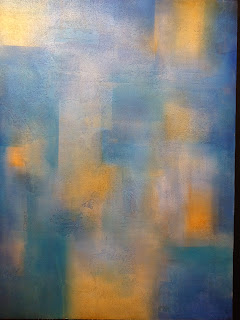Raul Piedra










Perpetuating a pioneering legacy
By Earl D.C. Bracamonte
Subtle earth tones, muted grays and subdued hues inhabit the palette of the late abstraction pioneer Raul Piedra, whose collection of works from 1992-2008 are now on display at the Crucible Art Gallery in SM Megamall. The mounted retrospective features single works as well as diptychs and triptychs.
Cross-sections of the terra firma in vibrant and contrasting muted colors, sunset streaks and azure splotches splattered ingeniously on the canvas round up the choice pieces on the gallery’s walls. Featuring experimental pieces as well as those employing mixed media (including series on “Envisage,” “Influx” and “Bluescape”), there are also a number of undated paperworks bundled together under “Untitled I-IV.”
“My husband started with surrealism. Before we were married, his colors were somber and bleak. It was only when the children were born that the colors got brighter and brighter. There are always yellows and blues in his works. These are hues that never fail to appear on the canvas. He likes blue because it bespeaks of landscapes and his inclination and love for travel. It’s the color he usually sees from a plane window,” related Baby Piedra during an exclusive interview.
Surrealism originated in France in the 1920s. In the words of its main theorist, the writer Andre Breton, its aim was to resolve the previously contradictory conditions of dream and reality; and the ways to which this was achieved varied widely. Artists painted unnerving and illogical scenes with photographic precision, created strange creatures from collections of everyday objects, or developed techniques of painting which would allow the unconscious to express itself. Surrealist pictures, while figurative, represent an alien world, whose images range from dreamlike serenity to nightmarish fantasy. Piedra’s works were on the dreamy, serene side of surrealism.
“His subjects were mostly culled from experiences with us his family. Earlier on, before totally immersing himself in abstraction, he would sketch the orchids from our small garden or the lovebirds on our window sill. He also drew the fishes we saw from the bay area during our daily promenade before dusk. Soon the images were of open doors to me nursing the kids,” reminisced the painter’s amiable widow. Though she said, it took her quite a while to get over her husband’s demise.
The abstraction meister did an interesting take on all his canvas works, wherein hints of color tells of his emotions during the time when the works were created. His obras in chrome and alabaster tones offer quiet moments; bearing the unmistakable imprint of Piedra’s minimalist approach.
Nearer to the colors and strokes of noted surrealist painter Arshile Gorky’s “The Waterfall,” Piedra’s works mostly employ chrome and yellow tones, sometimes cerulean shades, with minute touches of black and crimson to provide shadow and texture. After three decades of delving in the abstract genre, Piedra has mastered the textures with effortless ease.
“Raul is a lover of songs, we both are. That’s how we clicked. He actually taught me how to draw when we were still sweethearts. Eventually the drawing sessions stopped and family life took over. Our favorite songs are the Simon & Garfunkel classic “Bridge Over Trouble Water” and Sergio Mendes’ “Bridges.” That explains why he labeled one of his exhibits before as “Bridges” because that song, to us, spoke of familial connections,” she continued.
Piedra started doing posters at the tender age of eight and went on to do watercolor paintings at thirteen. As a young man, Piedra opted to do still life and figurative sketches and for a while was into surrealism, until he embraced total abstraction and found his forte after an Australian-New Zealand grant he completed between the years 1984 through 1992.
“His paintings were always in the same place when he was still alive. He said that when they were transferred, an artist loses momentum,” intoned Baby Piedra at the close of our colloquy.
Raul Piedra was born in Pampanga but grew up with his family in Tondo, Manila. He and wife Baby are blessed with seven children: two boys – Rossano Ray (27) and Rainier Ross (17) – and five girls – Ma. Rachella (38), Ma. Regina (33), Ma. Rhoda (29), Ma. Ranee (28), Ma. Renee Rose (18).
Aside from Ma. Rhoda who’s currently working in The Netherlands, the surviving family members reside in their new family home in Pasay City.
His 27-year-old son, Rossano Ray, who graduated from UST’s Fine Arts program, might follow in his footsteps as a visual artist. Fascinated with Japanese manga, the young Piedra might prove his mettle on the neo-surrealism genre. His interesting mural sits beside that of his father’s quiet abstraction piece along the Artists Wall in Makati’s Reposo Street (now Nicanor Garcia Avenue). Ma. Renne Rose, the sixth child, who’s now a freshman Fine Arts student at the Far Eastern University shows remarkable potential of also following on her father’s legacy.
“His mixture of colors and texture coupled with his sunny personality make Raul Piedra a desirable artist to feature. As pioneer, his palette template is copied by new crops of budding artists. It’s quite difficult to achieve the right color hue in layered works. It takes mastery to do that. Piedra is one of few pioneers in the league of Gus Albor, Egay Fernandez and Benjie Cabangis,” enthused gallery personnel Jun Veloso, who is helping curator Chari Elinzano.
The ‘Piedra Retrospective’ runs until Aug. 5 (Ma. Renee Rose’s birthdate) at the Crucible Art Gallery on the fourth level of SM Megamall’s bridgeway. For more information, simply call the gallery through tel. no. 635-6061 or email charrie14@yahoo.com.


Comments
Post a Comment